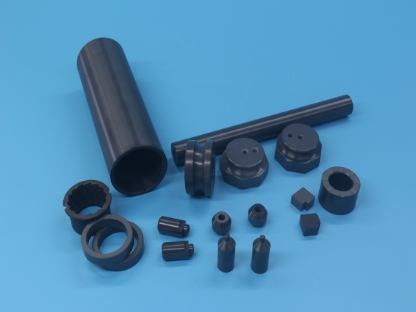Silicon carbide ceramics have significant advantages and wide applications in the field of new energy due to their excellent physical and chemical properties such as high hardness, high thermal conductivity, and low thermal expansion coefficient.

Some silicon carbide ceramic components produced by Mingrui Ceramics.
Advantages of silicon carbide ceramics in new energy
1. High thermal conductivity:
The thermal conductivity of silicon carbide ceramics is much higher than that of traditional materials, which enables it to effectively conduct and disperse heat in the field of new energy and improve energy conversion efficiency.
High thermal conductivity also helps to ensure the stability and reliability of equipment and extend the service life of equipment.
2. High hardness and wear resistance:
Silicon carbide ceramics have extremely high hardness and wear resistance, and can withstand high-intensity machining and operation.
This characteristic enables silicon carbide ceramics to withstand various challenges and maintain the performance of the equipment during the manufacture and use of new energy equipment.
3. Excellent chemical stability:
Silicon carbide ceramics can resist corrosion from chemicals such as acids and alkalis and have good chemical stability.
This ensures that the performance and stability of new energy equipment will not be affected by chemical corrosion during operation.
4. Low thermal expansion coefficient:
Silicon carbide ceramics have a low thermal expansion coefficient and can adapt to changes in different environments.
This enables silicon carbide ceramics to maintain stability and reliability during the operation of new energy equipment.
5. Good electronic properties:
As a semiconductor material, silicon carbide ceramics can be used in the manufacture of new energy equipment to improve energy conversion efficiency.
Its excellent electronic properties make silicon carbide ceramics have broad application prospects in the field of new energy.
Application of silicon carbide ceramics in new energy
1. Solar panels:
Silicon carbide ceramics can be used to manufacture high-efficiency solar panels to replace traditional silicon materials.
By improving the performance and life of solar panels, silicon carbide ceramics help to improve the overall efficiency and life of solar power generation systems.
2. Wind turbine blades:
Silicon carbide ceramics can be used to manufacture high-performance bearings and blades for wind turbines.
Its high temperature stability and high strength enable wind turbine blades to better withstand wind and mechanical stress, improving power generation efficiency and service life.
3. Fuel cells:
Silicon carbide ceramics can be used to manufacture core components of high-efficiency fuel cells, such as electrodes.
By improving the performance and life of fuel cell electrodes, silicon carbide ceramics help improve the overall performance and reliability of fuel cells.
4. New energy vehicles:
Silicon carbide ceramics are widely used in the field of new energy vehicles, such as inverters and on-board chargers for electric vehicles.
The use of silicon carbide devices can make the drive system of electric vehicles more efficient, compact and lightweight, and improve the range and performance of electric vehicles.
5. Smart grid:
Silicon carbide ceramics can be used to manufacture key components such as power switches in smart grids.
Its excellent electronic properties and low switching losses make silicon carbide ceramics an ideal choice for smart grid construction.
Silicon carbide ceramics have significant advantages and broad application prospects in the field of new energy. With the continuous advancement of new energy technology and the improvement of silicon carbide ceramic preparation technology, the application of silicon carbide ceramics in the field of new energy will become more extensive and in-depth.

 Moble: +86 18122974730
Moble: +86 18122974730 Phone: +86 746 3386888
Phone: +86 746 3386888 Email: admin@cerampart.com
Email: admin@cerampart.com Skype: +86 18122974730
Skype: +86 18122974730 Wechat: +86 18122974730
Wechat: +86 18122974730